#Climate fiction
Explore tagged Tumblr posts
Text
The history of Solarpunk

Okay, I guess this has to be said, because the people will always claim the same wrong thing: No, Solarpunk did not "start out as an aesthetic". Jesus, where the hell does this claim even come from? Like, honestly, I am asking.
Solarpunk started out as a genre, that yes, did also include design elements, but also literary elements. A vaguely defined literary genre, but a genre never the less.
And I am not even talking about those early books that we today also claim under the Solarpunk umbrella. So, no, I am not talking about Ursula K. LeGuin, even though she definitely was a big influence on the genre.
The actual history of Solarpunk goes something like that: In the late 1990s and early 2000s the term "Ecopunk" was coined, which was used to refer to books that kinda fit into the Cyberpunk genre umbrella, but were more focused on ecological themes. This was less focused on the "high tech, high life" mantra that Solarpunk ended up with, but it was SciFi stories, that were focused on people interacting with the environment. Often set to a backdrop of environmental apocalypse. Now, other than Solarpunk just a bit later, this genre never got that well defined (especially with Solarpunk kinda taking over the role). As such there is only a handful of things that ever officially called themselves Ecopunk.
At the same time, though, the same sort of thought was picked up in the Brazilian science fiction scene, where the idea was further developed. Both artistically, where it got a lot of influence from the Amazofuturism movement, but also as an ideology. In this there were the ideas from Ecopunk as the "scifi in the ecological collaps" in there, but also the idea of "scifi with technology that allows us to live within the changing world/allows us to live more in harmony with nature".
Now, we do not really know who came up with the idea of naming this "Solarpunk". From all I can find the earliest mention of the term "Solarpunk" that is still online today is in this article from the Blog Republic of Bees. But given the way the blogger talks about it, it is clear there was some vague definition of the genre before it.
These days it is kinda argued about whether that title originally arose in Brazil or in the Anglosphere. But it seems very likely that the term was coined between 2006 and 2008, coming either out of the Brazilian movement around Ecopunk or out of the English Steampunk movement (specifically the literary branch of the Steampunk genre).
In the following years it was thrown around for a bit (there is an archived Wired article from 2009, that mentions the term once, as well as one other article), but for the moment there was not a lot happening in this regard.
Until 2012, when the Brazilian Solarpunk movement really started to bloom and at the same time in Italy Commando Jugendstil made their appearance. In 2012 in Brazil the anthology "Solarpunk: Histórias ecológicas e fantásticas em um mundo sustentável" was released (that did get an English translation not too long ago) establishing some groundwork for the genre. And Commando Jugendstil, who describe themselves as both a "Communication Project" and an "Art Movement", started to work on Solarpunk in Italy. Now, Commando Jugendstil is a bit more complicated than just one or the other. As they very much were a big influence on some of the aesthetic concepts, but also were releasing short stories and did some actual punky political action within Italy.
And all of that was happening in 2012, where the term really started to take off.
And only after this, in 2014, Solarpunk became this aesthetic we know today, when a (now defuct) tumblr blog started posting photos, artworks and other aesthetical things under the caption of Solarpunk. Especially as it was the first time the term was widely used within the Anglosphere.
Undoubtedly: This was probably how most people first learned of Solarpunk... But it was not how Solarpunk started. So, please stop spreading that myth.
The reason this bothers me so much is, that it so widely ignores how this movement definitely has its roots within Latin America and specifically Brazil. Instead this myth basically tries to claim Solarpunk as a thing that fully and completely originated within the anglosphere. Which is just is not.
And yes, there was artistic aspects to that early Solarpunk movement, too. But also a literary and political aspectt. That is not something that was put onto a term that was originally an aesthetic - but rather it was something that was there from the very beginning.
Again: There has been an artistic and aesthetic aspect in Solarpunk from the very beginning, yes. But there has been a literary and political aspect in it the entire time, too. And trying to divorce Solarpunk from those things is just wrong and also... kinda misses the point.
So, please. Just stop claiming that entire "it has been an aesthetic first" thing. Solarpunk is a genre of fiction, it is a political movement, just as much as it is an artistic movement. Always has been. And there has always been punk in it. So, please, stop acting as if Solarpunk is just "pretty artistic vibes". It is not.
Thanks for coming to my TED Talk, I guess.

#solarpunk#solarpunk aesthetic#solarpunk fiction#political movement#history#history of solarpunk#amazofuturismus#put the punk back in solarpunk#scifi#science fiction#clifi#climate fiction#ecopunk
3K notes
·
View notes
Text
"To change our relationship to the physical world – to end an era of profligate consumption by the few that has consequences for the many – means changing how we think about pretty much everything: wealth, power, joy, time, space, nature, value, what constitutes a good life, what matters, how change itself happens. As the climate journalist Mary Heglar writes, we are not short on innovation. “We’ve got loads of ideas for solar panels and microgrids. While we have all of these pieces, we don’t have a picture of how they come together to build a new world. For too long, the climate fight has been limited to scientists and policy experts. While we need their skills, we also need so much more. When I survey the field, it’s clear that what we desperately need is more artists.”" -Rebecca Solnit. Emphasis added.
Artists are so so important. I've had people tell me they feel bad because, as an artist, they don't think they can contribute anything worthwhile to climate change. They're wrong.
We cannot build a future we cannot imagine. Artists are so important. Artists show us what could be - what we could be
#artists are so so important#climate change#climate crisis#climate news#climate action#quote#quotes#rebecca solnit#literature#climate fiction#clifi#science fiction#the arts#not news#hope#hope posting#solarpunk#hopepunk#excuse my pretentiousness in that last bit pls#art appreciation#artist appreciation#this goes for all types of artists btw!!
348 notes
·
View notes
Text

The 2024 Solarpunk Conference is almost here! It's on Saturday and it's totally virtual. Christina and I are gonna be there talking about conflict in solarpunk fiction with some extremely rad presenters; I highly encourage you to check it out!
@solarpunkmagazine
#the solarpunk conference#solarpunk#the solarpunk conference 2024#conference#conference schedule#solarpunk fiction#solarpunk storytelling#climate fiction#hopepunk#hopeful storytelling#conflict in solarpunk storytelling#conflict in utopian storytelling#stelliform press#solarpunk magazine#grist
102 notes
·
View notes
Text
For decades we dreamed dystopia, and in March of 2020, when COVID crashed upon U.S. shores, it seemed like we had dreamed it so well we wished it into being. While wealthy reactionaries are building actual bunkers and prepping for environmental collapse, fantasizing about which shade of hopelessness our apocalypse will take is a luxury we can no longer afford. By accepting as inevitable humanity’s demise by its own hand, post-apocalyptic fiction places no responsibility on the living to course correct.
These days, climate change isn’t over the horizon, it’s here. The virus that shuts down the globe? We had that, too. Dystopian fiction? That’s so 2012. It’s time we collectively dream of something else. A better world is possible, but if artists and writers are to contribute to that better world, we’re going to need to balance our splendid hellscapes with gardens of earthly delight. We need to envision futures that are livable and happy, and we need to imagine how we get there from here. What’s more, we need to make those worlds as thrilling and engaging as any post-apocalyptic zombie-strewn nightmare.
Fortunately, we don’t need to invent a new literary genre to show us the way to a better tomorrow. Just as there is a left-wing climate movement demanding humanity break from fossil fuels to create a bright future for life on Earth, so is there a parallel climate fiction that allows us to imagine that better world. In steps solarpunk, left-wing literature’s answer to the dystopian novel. Solarpunk looks towards a post-capitalist future of renewable energy. It rejects climate “doomerism” and shows what our collective future could look like if we heal our relationship with the natural world.
Far from Star Trek’s “full luxury space communism,” where humans race across galaxies via endless sources of energy, the technology in solarpunk is imminently achievable. In the anthology Future Primitive: The New Ecotopias, science fiction writer and democratic socialist Kim Stanley Robinson describes this genre as rejecting “the inevitability of the machine future.” Instead it asks, “What is the healthiest way to live? What is the most beautiful?” Rather than Elon Musk’s tent cities on Mars, these fictional worlds “cobble together aspects of the postmodern and the paleolithic, asserting that we might for very good reasons choose to live in ways that resemble in part the ways of our ancestors.”
-via Current Affairs, March 25, 2024
#solarpunk#clifi#scifi#climate fiction#climate change#climate action#hope#hope posting#hopepunk#dystopia#utopia
35 notes
·
View notes
Text
Solarpunk Magazine Issue 18 Released!
And it's on sale for $4 through this weekend! Check out our website for all of our issues.
20 notes
·
View notes
Text
EARTH IS MISSING! / EVERYONE'S WORLD IS ENDING ALL THE TIME
this spring I entered the Elizabeth Soutar Bookbinding Competition held by the National Library of Scotland. The theme this year was climate change. I didn't win any of the categories (I certainly didn't think I'd win any of the Craft categories, but I thought I had a decent shot at the Creative categories) but I am very happy with how my binding came out anyway!
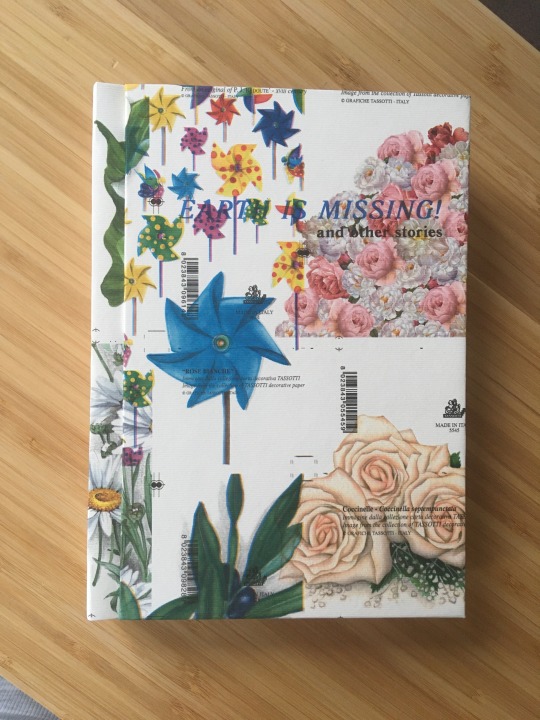
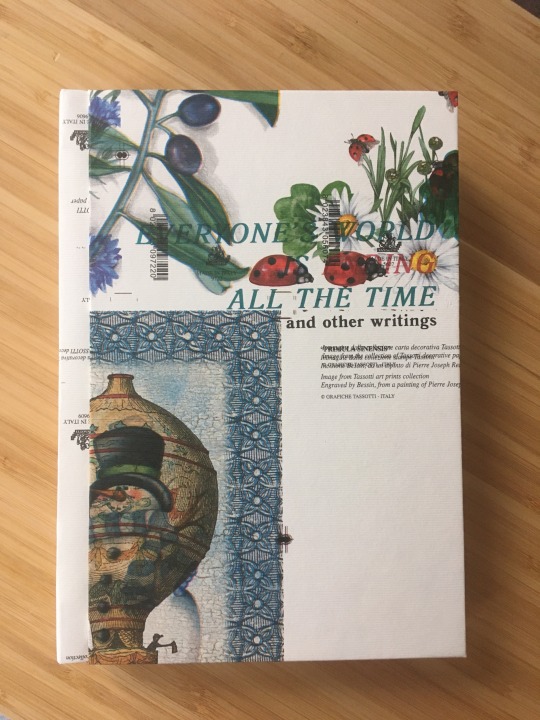


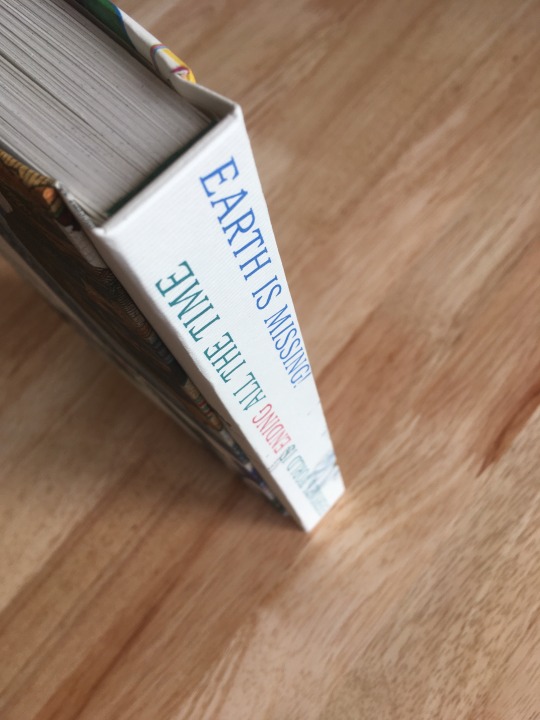

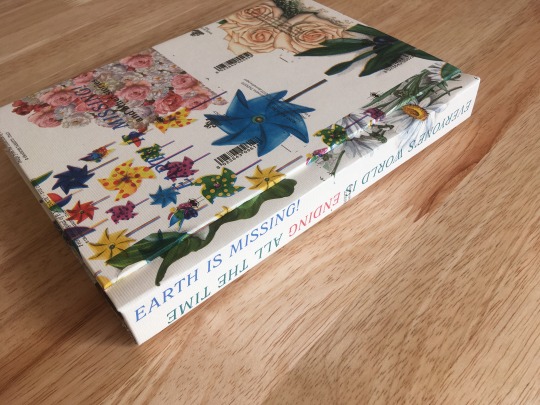

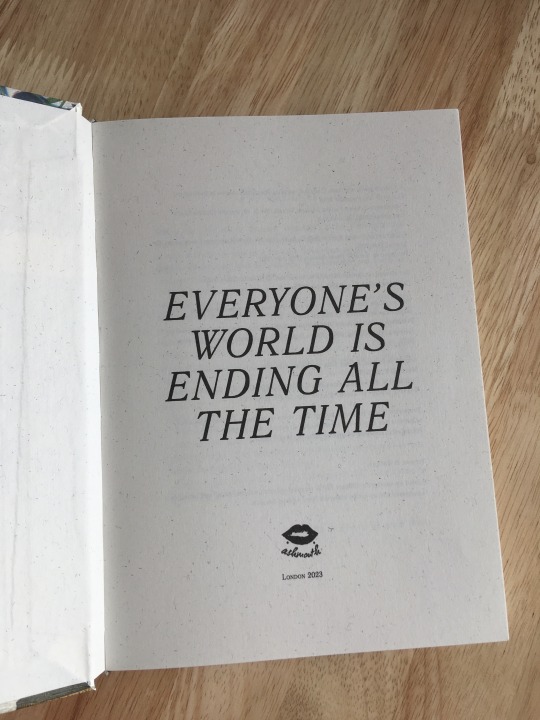



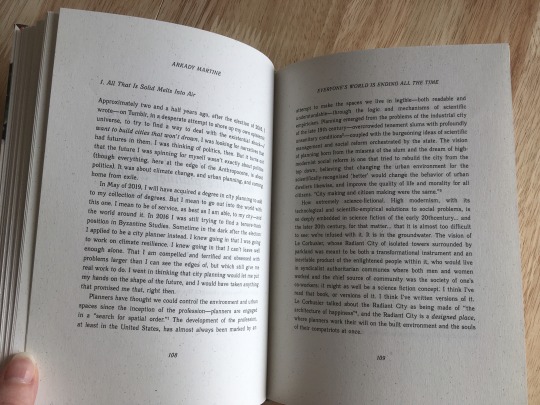
under the cut is the details of the binding and the process that went into it, plus a full list of the texts included.
this is a modified 3 piece bradel binding - a 3 piece bradel is usually made with leather spine with the spine attached to the textblock and the front and back covers added on after. there's another variety of a 3 piece bradel case where the spine and boards are assembled with a thin piece of paper to later be covered with a bookcloth. I wanted to use some leftover misprint cardstock I had (the same stuff I'd previously used to make paperbacks) and I wanted to print the titles directly onto the covers and spine (specifically I wanted to overprint the titles to imitate the existing misprint), and in order to fit it through my printer I had to have it in three pieces. so I assembled a bradel case as if it were to be covered with a cloth, only the cardstock I was using to assemble the case would also be the cover material.
everything I used to make this book was recycled or reused, with the exception of the greybeards which were new (I didn't have any rescued book boards from secondhand books at the time). the text paper is recycled eco-craft paper, the endbands are re-used macramé cords wrapped in green wrapping paper that came from a gift bag, and as mentioned, the cover material comes from a misprinted running sheet.
a few process photos of getting the case together:

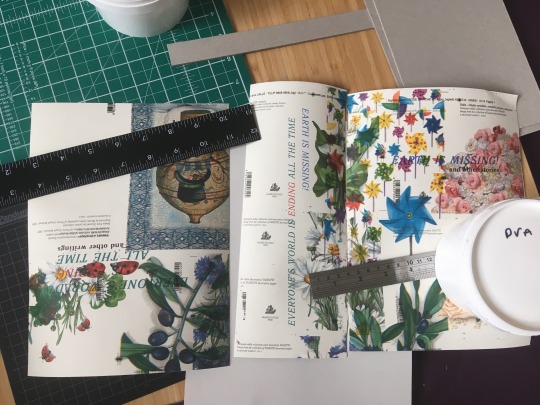

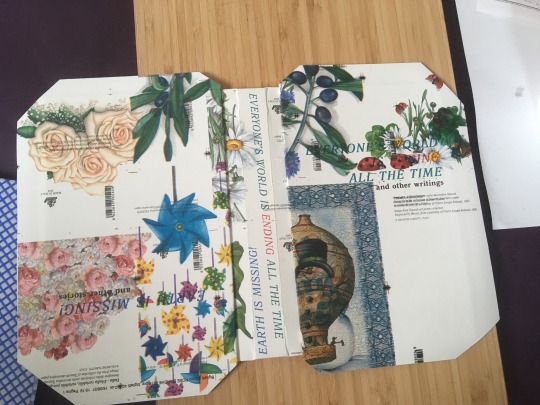
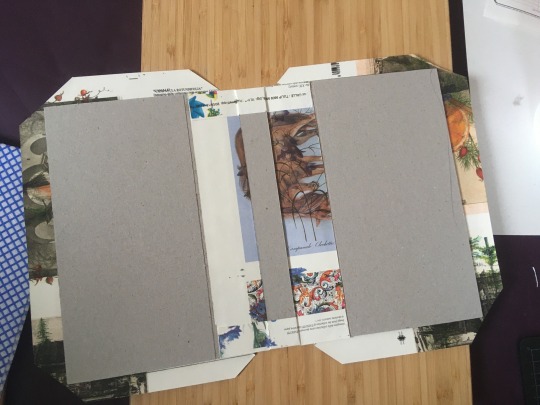

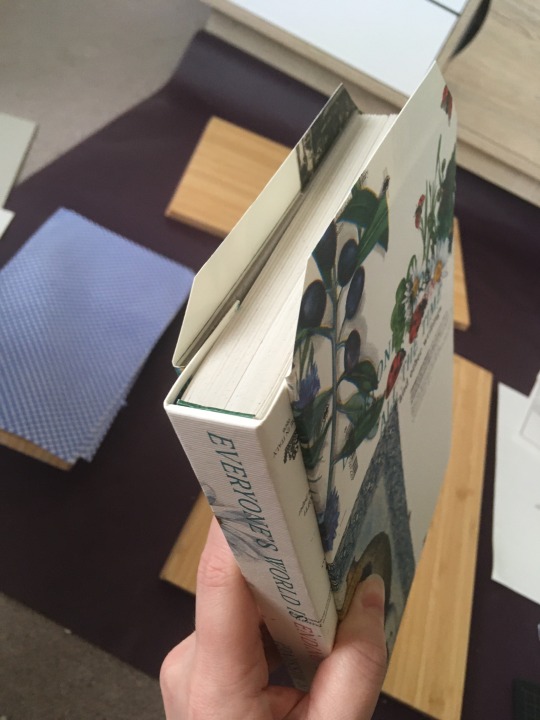

in terms of content, I took care that not only should the binding fit the theme of climate change - by using recycled and reused materials - but the text inside should also fit the theme. there were a lot of considerations there because I could easily have just bought a copy of something like Greta Thunberg's speeches and rebound them, but I wanted the texts to be something that made sense to me. so I went and looked at the SFF magazines I read for climate fiction and essays, I looked for academic papers, and I looked on Gutenberg for older pulp fiction relating to climate change. once I had a selection of texts I pared them down to two categories, fiction and non-fiction, and decided the most fun way to bind them would be as a tête-bêche with fiction on one side and non-fiction on the other, and this then informed how the binding would physically turn out - the modified 3 piece bradel.
here is the full table of contents for each side of the book:
EVERYONE'S WORLD IS ENDING ALL THE TIME and other writings
A Climate of Competition: Climate Change as Political Economy in Speculative Fiction, 1889–1915 by Steve Asselin Published in Science Fiction Studies, Vol. 45, No. 3, SF and the Climate Crisis (November 2018), pp. 440-453
A Century of Science Fiction That Changed How We Think About the Environment by Sherryl Vint Published in the MIT Press Reader, 20th July 2021
The climate is changing. Science fiction is too. by Eliza Levinson Published in The Story, 30th June 2022
’Not to escape the world but to join it’: responding to climate change with imagination not fantasy by Andrew Davison Published in Philosophical Transactions: Mathematical, Physical and Engineering Sciences, Vol. 375, No. 2095, Theme issue: Material demand reduction (13 June 2017), pp. 1-13
Science in Fiction: A Brief Look at Communicating Climate Change through the Novel by Eline D. Tabak Published in RCC Perspectives, No. 4, COMMUNICATING THE CLIMATE: From Knowing Change to Changing Knowledge (2019), pp. 97-104
Everyone’s World Is Ending All the Time: notes on becoming a climate resilience planner at the edge of the anthropocene by Arkady Martine Published in Uncanny Magazine issue 28, May 7, 2019
EARTH IS MISSING! and other stories
Earth Is Missing! by Carl Selwyn in Planet Stories (1947)
Climate—Disordered by Carter Sprague in Startling Stories (1948)
Climate—Incorporated by Wesley Long in Thrilling Wonder Stories (1948)
A Being Together Amongst Strangers by Arkady Martine in Uncanny Magazine (2020)
You’re Not The Only One by Octavia Cade in Clarkesworld Magazine (2022)
Why We Bury Our Dead At Sea by Tehnuka in Reckoning Magazine (2023)
#my binding#bookbinding#Elizabeth Soutar Bookbinding Competition#recycled materials#reused materials#climate fiction#climate action
165 notes
·
View notes
Text
Free queer sci fi books!!!
I am obsessed with queer sci fi, because, well, look at me, this is not a surprise to anyone. I bought Cascade immediately because "gay disaster wizards" is basically my entire sexuality.
But what if you also like gay disaster wizards but you are broke? Maybe you're striking? Maybe you're just trapped in late-stage capitalism and the whole gig economy thing isn't working out as planned? (Or is working exactly as planned, which was designed to crush the little people, which is one more theme in Cascade, it is a very relatable book).
Never fear! There's a giveaway going on, get it free in return for signing up to a newsletter. Normally I'd tell you to subscribe, get it free, and unsub, but the newsletter literally is just about giving away monthly queer sci fi so um, this seems like a good deal all around.
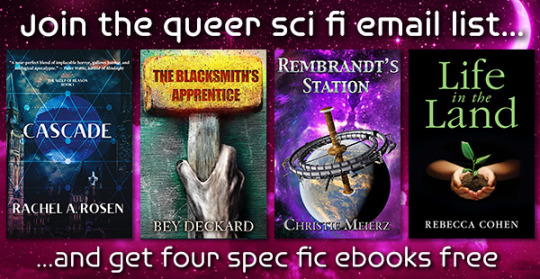
I think this deal is only for July? Honestly I'm not certain. But if you click this link and it doesn't work anymore, there's always this newsletter which gives you a couple free short stories from the Cascade universe.
140 notes
·
View notes
Text
I just subscribed to Solarpunk Magazine 2025 and backed the City Of Hope TTRPG! Very cool project, go check it out! https://www.kickstarter.com/projects/solarpunkmagazine/city-of-hope-0?ref=thanks-copy
17 notes
·
View notes
Text

Stede and Ed hanging out in the snow on an ice ship. @y2jenn made this beautiful piece for @veeagainsttheday's and my post-apocalyptic ice piracy AU/climate change fic Runaway Effects. Go give Jenn some love because she's the best and I stare at this art all the time!! Also our fic is rated E for Explicit because, well, obviously they do more than just cuddle for warmth. ;)
#ofmd fanart#ofmd fanfic#ice pirates#edward x stede#edward teach#stede bonnet#blackbeard#our flag meets death#ofmd#huddling for warmth#team icy hot#gentlebeard#snowball earth#it's very very cold on earth but stede and ed warm each other up very very nicely#climate fiction#solarpunk fiction#clifi#world building#post apocalypse
68 notes
·
View notes
Text
If all things were possible, what kinds of technologies and miraculous feats of science do you think would put mankind in harmony with the Earth?
Happy Earth Day from the Science-Fiction Nerds at Kaleidoscope World. 💕
#Earth Day#Earth Day 2024#science fiction#Climate fiction#Sci-fi#cli fi#environmentalism#ecopunk#solarpunk#green future#better future#climate action#Imagination and Science#Science Fiction for Science#Science Fiction for the Environment#Good News#Good Earth#climate optimism#sci fi prompts#scifi writing#scifi fantasy#science fantasy#hopepunk#humanity#faith in humanity#Faith in science#Love for the Earth#question#hypothetical question#writing prompts
15 notes
·
View notes
Text
instagram
Grist 2200 is an amazing site to read climate fiction stories! They host a competition every year for climate fiction, and the winners they choose are really spectacular, and they're great reads. You can find the stories here.
Grist on its own is already gorgeous reporting on climate, and it's non-profit journalism, so make sure they're in your rotation as well.
#solarpunk#sustainability#climate change#climate crisis#climate fiction#hope#fiction#writing#Instagram
17 notes
·
View notes
Text
Solarpunk Autumns. Solarpunk Winters.
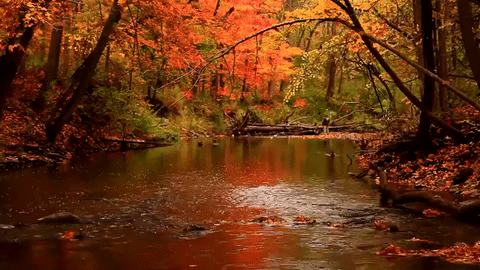
Solarpunk as a genre exists in a state of a permanent summer. Both as a genre, and an aesthetic. Solarpunk pictures usually show us worlds that have everything in so many shades of green. Green bushes. Green trees. Green everything. Fields in Solarpunk are always filled with ripe corn and wheat. And trees in Solarpunk are full of ripe fruit.
But if we look into Solarpunk worldbuilding there is also the fact that of course at some point at many places of the world it will become autumn, and winter.
I mean, I am feeling it right now, sitting here in my bed with three blankets and shivering, as the summer has very suddenly ended.
Sure, Solarpunk originated from Brazil. And while I do not know a whole lot about Brazillian climate, I do understand that it is close enough to the equator to be fairly warm yearround.
But I honestly would love to see more stories and artworks set in Solarpunk worlds during the autumn and winter. Especially because it is a very interesting topic when it comes to both the renewable energies and the food systems of Solarpunk worlds.
Now, admittedly, the renewable energy is less interesting to me, but we still should talk about it. In winter and autumn a lot of the renewable energy sources are a bit less viable. The sun has less energy and the further north (or south) you go, the less sun you get during the winter. Wind turbines also often struggle because there is in fact too much wind - and some older turbines do not do too well during harsh winter conditions. Water usually has less of a problem, unless the water energy is created in shallow conditions where the water freezes. But of course, there is nuclear energy to take care of most issues, even if everything else fails - even though some people still do not want to hear about it.
The food aspect is a lot more interesting though, especially from a modern point of view.
Because we people today are very used to eating the same stuff year around. Like potatoes, carrots, bellpeppers, tomatoes, cabbage, oranges, apples, pears, and bananas are usually available in the supermarket no matter when you go there. But of course we also know that those only are there because of the rather destructive ways we use to cultivate food and bring it to us. These things usually are grown somewhere closer to the equator and then are brought to Europe/North America via plane, emitting a lot more CO2.
Of course, this is a fairly new development. For the most of human history, nobody - or only the very richest people - had access to imported food like that. So instead they would only eat was either was available in their own country and their own fields right now, or that they could conserve in some way or form.
And frankly... I think that is something I would like to see some more off in Solarpunk media. In people not needing everything to be available all the time. And people also working to conserve food in one way or another to make it last longer.
Also I do want to bring it up again: There were a lot of well known "winter vegetables" in Europe during most of our history there. Stuff that would get ripe in late autumn and would keep rather well. And a lot of those vegetables have been forgotten.
So... Yeah, I really would see that issue discussed a bit more.
And sure, we might be able to worldbuild around the issue in some degree with greenhouses and stuff. But I think it would be nice to just question our relation with the always available foods.
#solarpunk#lunarpunk#food culture#food#vegetables#fruits#renewables#renewable energy#history#scifi#clifi#climate fiction
236 notes
·
View notes
Text
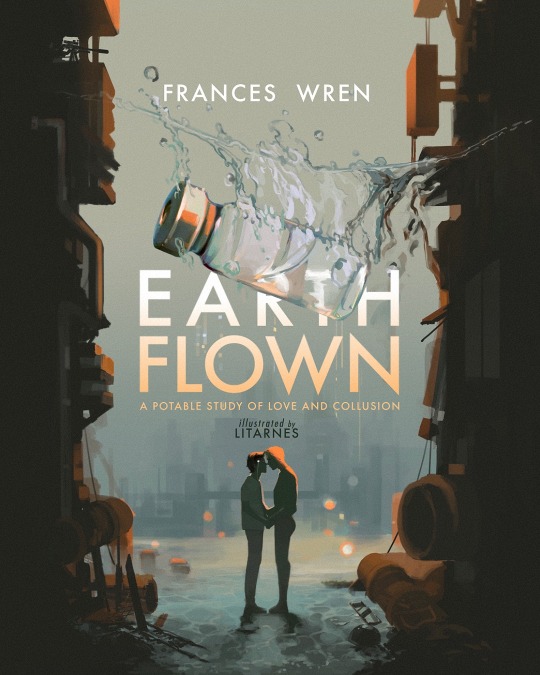
✨Earthflown by Frances Wren
(releases on April 16th)
When Ethan saves the life of a firestarter, it's nothing unusual. He's the only healer on call at the hospital – and that gunshot wound isn't going to regenerate itself. But his patient turns out to be Corinna Arden, heiress to a pharmaceutical empire controlling Britain's water supply. Her twin, Javier, is a man who (a) starts sending Ethan flowers at work, (b) seems terrified of a secret, and (c) has the cheekbones and earnestness to make up for both.
Ethan indulges in (what he thinks will be) a brief, harmless romance – but is swept up in a deadly collusion over Project Earthflown: the largest reconstruction tender since London clawed its way out of the rising sea.
Determined to follow the money, Ollie is a journalist who finds a corpse at the end of a too-convenient tip. The fate of water - and who profits - might depend on the perennial question: Has Ethan lost his mind, or is he just an idiot?
-- Earthflown is a love story that tries – and fails – to leave the water crisis behind. Set in near-future, post-flood London, the novel takes a grounded approach to fantasy archetypes, where futuristic medicine meets a bit of magic. The Indigo exclusive edition with exclusive bonus scenes is available for preorder now ! You can already add the Book to your "want to read" shelf on goodreads or storygraph as well as browsing through it's very own website at earthflown.com
#Earthflown#Frances Wren#Litarnes#queer scifi#upcoming queer books#found family#hurt/comfort#climate fiction#asexual representation#own voices novel
20 notes
·
View notes
Text

Hey, do you want to read a FREE short story that Alex Brown at Reactor Magazine described as "a good reminder that queerness isn’t just an identity, it’s a way of being, a political movement, a revolutionary ideology, and a community"? Well if you do, my story "The Last Great Repair Tech of the American Midwest" is now available for free on Reckoning's website! Go forth!
#op#short story#short story writing#science fiction#climate fiction#I uh... struggle to market/advertise my stories if you couldn't already tell. so here's a meme.#story: the last repair tech
7 notes
·
View notes
Text
Private Rites
Book: Private Rites by Julia Armfield
⭐⭐⭐⭐⭐
You can almost feel the ever-constant rain pit-pattering on your brain as you read.
At my age, as young as my early twenties, I’ve spent much of my life being told the world is heading toward certain doom. Even in a state as red as the summer setting sun, so deep in denial of our weather’s fluctuations despite having more hurricanes with extreme behaviors, freezes deep enough to destroy our pipes never designed for this kind of winter, and hitting heat records earlier and later in the year than ever before.
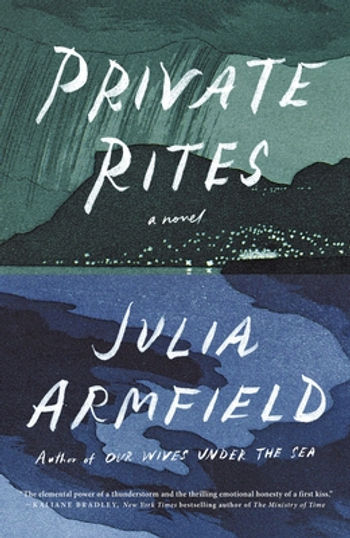
The climate is a topic many people are very passionate about, yet it’s one I’ve heard become quieter amidst louder conversations. Many readers within my circles know I’m pretty loud about LGBTQIA+ rights, and it’s the subject I speak the most on (particularly because it’s the one I’m most knowledgeable on). Of course, color me fascinated the moment I was offered an ALC (Advanced Listener’s Copy) of Private Rites. I have had her book Our Wives Under the Sea on my radar for a while, and still fully intend to read it. When I read the blurb, I dove headfirst in.
As a first impression, Hannah van der Westhuysen’s voice felt like a wind blowing through your hair before lifting you off your feet and straight for the ground to start off the audiobook. I mean that in the best possible way, because I was immediately intrigued in the dreary and somber mood their tone sets. Their narrating through the whole book is done well with subtle changes in the perspective shifts between the three sisters to help differentiate each character. The cadence and huskiness in which they read creates a fantastic atmosphere for the book to be set within.
The story itself is a reimagining of King Lear, where the three sisters - Isla, Irene, and Agnes - are left with the loss of their callous and cold father among a world slowly drowning in a gentle, endless rain. While the three are navigating this not-so-sudden death and their estranged relationship with one another, they also struggle with the frayed ends of their lives, whether it be a love breaking away, a love that refuses to be let go, and a love just begun. The tension only makes them grow further apart as the will of their well-known architect of a father reveals favor to one sister over the other two.
Each of the characters, including the sisters and their partners, are written with a depth that makes them feel real. The issues they struggle with, their anxieties and worries, their anger and stress, all gives them dimension that I could imagine them as people I could have met in passing, with lives beyond the eyes of a stranger.
You can almost feel the pitter-patter of the never stopping rain on your brain from the moment you begin this book and weeks after you’ve finished it.
Julia Armfield has made a masterpiece of climate fiction. Van der Westhuysen delivers a breathtaking performance in this audiobook and will definitely be on my radar in the future. (Add. note: Fun fact! They acted in the Fate: The Winx Saga on Netflix! I haven’t watched it, but I thought that was a cool fact. I will always remember them first for this audiobook though, appreciatively). I would highly recommend this to anyone else with an eye out for either a speculative climate fiction book or a modern retelling of King Lear dripping with raindrops.
For those who, like 5% of the population and myself, who struggle with Seasonal Depression (or any other form of mood disorder), please get yourself some water and a more cheerful book to recover from this review. It may be difficult in this period to self-care, but please remember that if anything is worth doing, it is worth being done half-way. Treat yourself like you would a dear friend.
In any case, I want to thank Libro.fm and Macmillan Audio for gifting me this ALC through Libro’s bookseller program and my job as a bookseller. I also want to thank both Julia Armfield and Hannah van der Westhuysen for bringing this amazing queer climate fiction to life for the world to admire and appreciate. Last but not least, I thank you, dear reader, for reading and patiently supporting my blog, and I remind you that in this vast and sometimes lonely universe, you matter so much to me. Take care of yourself and don’t forget your meds and hydration! Until next time, I’ll be reading!
If you’re interested in this book, buy it from one of these links here! Bookshop.org - Barnes & Noble - Libro.fm [audiobook] or from your local bookstore! If you'd like to support my personal favorite bookstore, buy it from Katy Budget Books!
To bring up the downcast mood this review presents, I have this afternote for my fellow catastrophisers that need a pick-me-up to wrap the book review burrito better.
Even in what can feel like the dreary outlook of this world, there have been many monumental efforts made to bettering it and signs those efforts are working; in the past year or so alone, we have seen loggerhead turtles making a comeback in population based on an increase in their nesting population, renewable energy is projected to be on a big rise in several states and countries across the globe, and deforestation in Colombia and in the Amazon Rainforest have reached their lowest level in a substantial period. There is good news out there, it just takes a bit of effort to find compared to the doomsday posting social media algorithms tend to push. I personally like to look at OneTreePlanted's positive environmental stories posts when I'm looking for some good news about the world (which is where I found most of the above news as it made me smile) - plus, looking it up on your preferred search engine should produce some results, too.
#books#books and reading#climate fiction#litfic#literary fiction#queer fiction#lgbtq fiction#book review#alc
3 notes
·
View notes
Text
Absolution release!
There was never full closure to the story of Area X. There were a few mysteries that had gone unsolved, some key points of view never aired. There were stories left to tell. There remained questions about who had been complicit in creating the conditions for Area X to take hold; the story of the first mission into the Forgotten Coast—before Area X was called Area X—had never been fully told; and what if someone had foreseen the world after Acceptance? How crazy would they seem?
Structured in three parts, each recounting a new expedition, there are some long-awaited answers here, to be sure, but also more questions, and profound new surprises.

Bookshop.org
Barnes & Noble
This book is broken up into three parts: 20 years before Area X, 18 months before Area X, and 1 year after Area X. Each of the three reveals more about the Forgotten Coast and its terroir, and more about Central and its mind control. There are gleanings of what Area X is and how it came about, but just like the other books in the Southern Reach trilogy, no true answers are provided.
Story 1 looks at an expedition of biologists on the Forgotten Coast and plays with some of the theories of Area X -- from time dilation to Central experiment to sleeping entity. Story 2 follows Old Jim just before the border came down, and we get to peek behind the curtain of the S&SB (and Central). And Story 3 follows the first expedition into Area X....or at least the first that we know of.

Interested? Check out my full review!
New to the world of Area X? Check out my review for Annihilation, the book that started it all; for Authority, where we get to peek behind the curtain; and Acceptance, where the mysteries of Area X begin coming to light.
#book#books#book recommendations#bookstagram#bookaholic#bookish#bookblr#booklr#book release#book birthday#book blogger#jeff vandermeer#southern reach trilogy#annihilation#authority#acceptance#eco horror#weird fiction#speculative fiction#climate fiction#spy novel#netgalley#netgalley review#netgalley read#advanced reader copy
4 notes
·
View notes